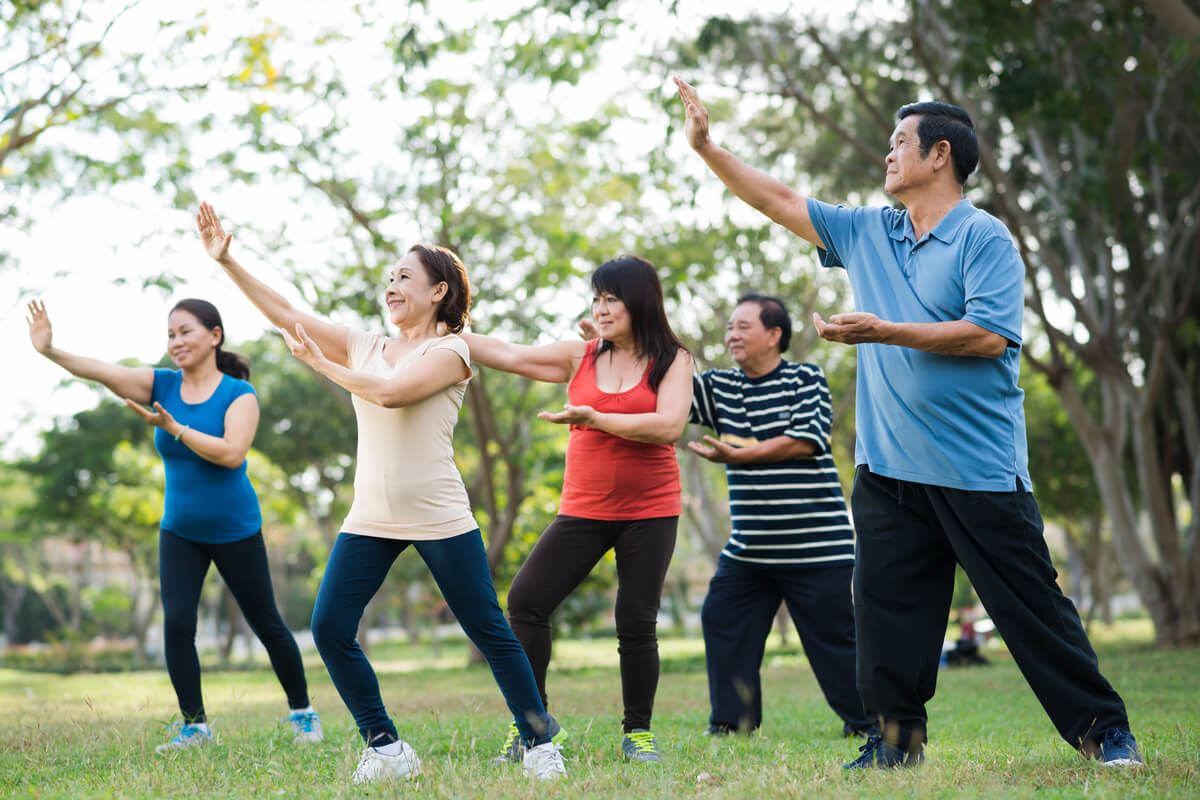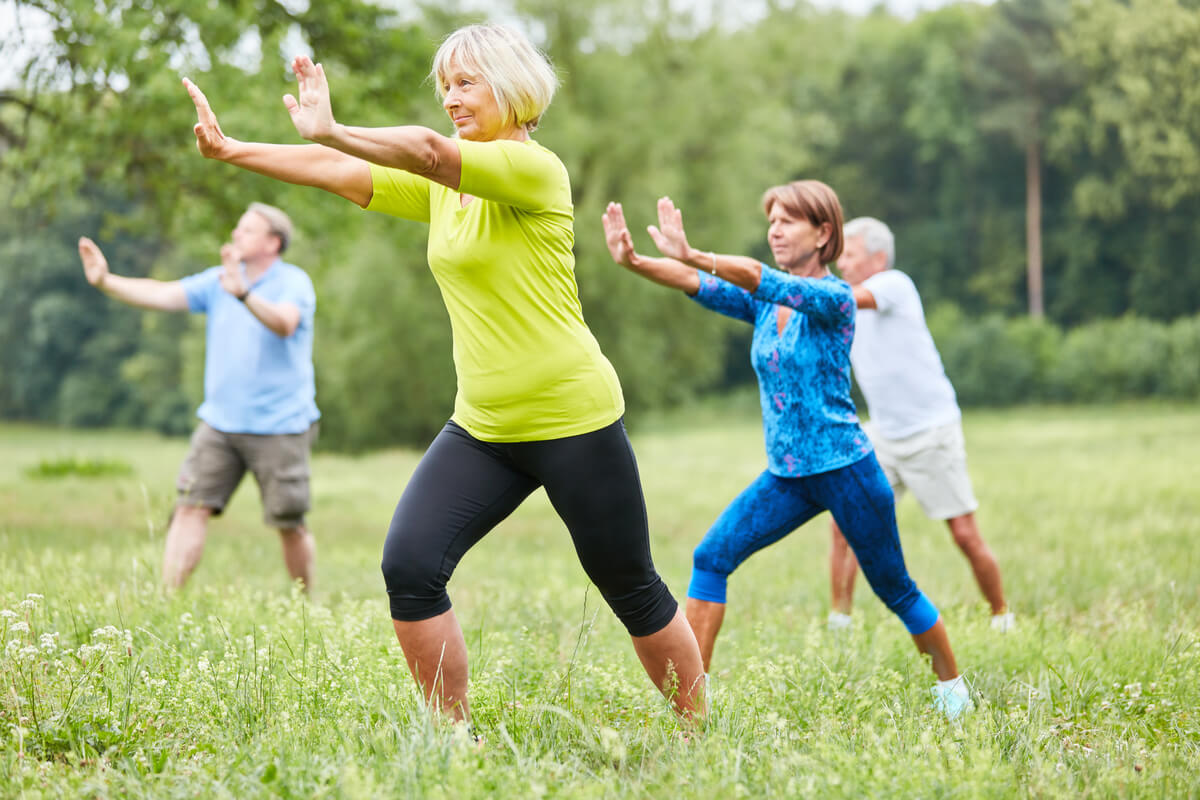What is tai chi?
Tai chi is an ancient Chinese martial art that combines gentle continuous movements with mental focus, relaxation, and deep breathing. (22) Tai chi is sometimes referred to as meditative movement. (20) There are five main styles of tai chi including Chen, Yang, Sun, Wu, and W’u. (8)(24) These styles developed by various individuals and families in China, differ slightly in their forms of movement and difficulty levels. However, they all combine controlled and gentle meditative movement with the concept of Qi, an energy source based in Chinese philosophy that circulates throughout the body. Tai chi is believed to support the healthy flow of Qi and promote harmony and balance in the body. (8)(24)Did you know? Similar to tai chi, qigong is an ancient health-enhancing practice that is used to restore Qi in the body. Qigong was developed before tai chi, and unlike the somewhat more complex and choreographed movements of tai chi, qigong movements are simpler, more repetitive, and easier to master. Tai chi often incorporates elements of qigong. (6)(13)

Tai chi exercises are called forms and transition from one to the next.
Tai chi exercises
There are over 100 different tai chi exercises. (27) These exercises are commonly referred to as “forms.” Tai chi forms are gentle and include specific movements that transition from one to the next, following a particular order. The different forms may include movements such as turning, twisting, rotating from the core, shifting your weight from side-to-side using your legs, performing pushing and pulling motions with your hands, and extending your limbs in different directions. Tai chi is often performed with slightly bent knees; however, this varies depending on the form. (31)Health benefits of tai chi
Tai chi is thought to foster inner peace, well-being, and self-awareness. (20) This meditative exercise may also improve cognitive function and balance in older adults and provide benefits to individuals with certain conditions such as osteoarthritis, Parkinson’s disease, and chronic obstructive pulmonary disease (COPD). (20)1. Balance and falls
Tai chi may be recommended for older adults with a fear or risk of falls as studies show that practicing tai chi may reduce the fear of falling in older adults who are often more prone to falls. (5) In fact, it’s not uncommon for communities and long-term care facilities for older adults to recommend tai chi for seniors. (1) A systematic review that examined the effectiveness of tai chi in reducing the fear and incidence of falling in 1,146 older adults determined that there was strong evidence to support the practice of tai chi for reducing the fear of falling. The review concluded that there was some evidence to support tai chi for reducing the incidence of falling; however, more well-controlled studies are needed to support these findings. (3) One meta-analysis examined the effectiveness of tai chi on the incidence of falls, fear of falling, and balance in 2,203 older adults. Compared with exercise controls tai chi significantly decreased fall rates and improved static balance. When compared with non-exercise controls, tai chi did not reduce fall rates or improve static balance. However, participants did experience a significant decrease in their fear of falling. While these findings suggest that tai chi may reduce the fear of falling in this population, more evidence is needed to determine how effective tai chi may be for fall prevention in older adults. (12)Did you know? Tai chi may be a cost-effective way to help prevent falls in older adults living in long-term care facilities. (1)
2. Cognitive function
Practicing tai chi may have positive effects on elements of cognitive function in older adults. (9) Compared to non-exercise control groups, studies included in a meta-analysis that examined the impact of exercise on cognitive function in healthy older adults determined that attention and processing speeds were improved in the tai chi exercise groups. (7) Another review examined the effects of tai chi on cognitive function in older adults living in community dwellings (such as retirement residents or nursing homes). Ten of the 12 studies included in the review noted improvements in language, learning, memory, and executive functioning in individuals practicing tai chi. (14) In this case, further well-controlled studies are needed to support these findings.3. Osteoarthritis
Exercise including tai chi may be associated with benefits for certain types of osteoarthritis (OA). (5)(29) OA is a condition that can occur when the protective cartilage that covers the end of bones breaks down, causing the bones to rub together and resulting in pain. (15) OA often affects the cartilage in the feet, hands, spine, and knees, and it is the most common type of arthritis. (15) A systematic review that examined the effectiveness of tai chi for patients with knee osteoarthritis determined that tai chi may relieve pain and improve physical function. (30) In fact, the American College of Rheumatology has recommended tai chi for the management of knee, hip, and hand osteoarthritis. (4)
Tai chi may improve physical function in people with osteoarthritis. (30)
4. Parkinson’s disease
Tai chi may be associated with improved physical function for individuals with Parkinson disease (PD). (5) Parkinson’s disease is a disorder that occurs when brain cells don’t produce adequate dopamine (a neurotransmitter), affecting movement, emotions, motivation, and other sensations such as pleasure. (16) A meta-analysis that examined the efficacy of tai chi for patients with Parkinson’s disease who also took medication for the disease determined that tai chi may be effective for improving balance and motor function. While these results are promising, more research is needed to confirm these benefits. (32) Another study examined whether tai chi could improve postural control in patients with Parkinson’s disease compared to stretching and resistance training. Results demonstrated that individuals with mild to moderate Parkinson’s disease who participated in 60 minutes of tai chi twice per week for 24 weeks experienced an improvement in balance, better functional capacity, and fewer falls compared to stretching and resistance training group. (10)5. Chronic obstructive pulmonary disease
Tai chi may improve quality of life and enhance exercise capacity in individuals with COPD. (28) COPD is an inflammatory condition that obstructs airflow in the lungs. (2) A systematic review and meta-analysis examined the influence of tai chi on COPD. The studies included in the analysis utilized different methods for measuring outcomes including the six-minute walking distance (6MWD), the percentage predicted forced expiratory flow volume in the first second, and the St. George’s respiratory questionnaire (SGRQ). Compared to control groups, outcomes improved significantly in the tai chi groups, including shortness of breath, exercise capacity, and quality of life. (11)Other benefits of tai chi
While more research is necessary, tai chi may also be associated with benefits to individuals with the following conditions:- Cardiac and stroke rehabilitation (18)(19)(23)
- Cognitive impairment and dementia (26)
- Depression (25)
How to get started with tai chi
The best way to get started with tai chi is to take a class with a qualified instructor. Tai chi classes are often offered through local community and recreation centers at affordable rates. Tai chi videos are also available online and through mobile apps. Consider the following tips if you’re new to tai chi:- Try watching a tai chi class online or in person before taking your first class. This will help you get a better understanding of how the exercises are performed and feel more comfortable with the type of movements.
- Dress in comfortable, loose fitting clothes. Choose light but supportive footwear.
- Check with your healthcare practitioner before taking a tai chi class in order to ensure that it’s the right fit for you.
The bottom line
Tai chi is a Chinese martial art that’s sometimes referred to as meditative movement. It combines gentle continuous movements with mental focus, relaxation, and deep breathing. (22) Tai chi is believed to support the healthy flow of Qi and promote harmony and balance in the body. (8)(24) Some of its evidence-based benefits of tai chi may include reducing the fear of falling in older adults with poor balance, improving cognitive function in older adults, and providing benefits to individuals with osteoarthritis, Parkinson’s disease, and COPD. (20) Always speak with your healthcare practitioner before beginning a new exercise routine to ensure that it’s right for your wellness plan.- Church, J., Goodall, S., Norman, R., & Haas, M. (2011). An economic evaluation of community and residential aged care falls prevention strategies in NSW. New South Wales Public Health Bulletin, 22(4), 60–68.
- Devine, J. F. (2008). Chronic obstructive pulmonary disease: An overview. American Health & Drug Benefits, 1(7), 34–42.
- Harling, A., & Simpson, J. P. (2008). A systematic review to determine the effectiveness of tai chi in reducing falls and fear of falling in older adults. Physical Therapy Reviews, 13(4), 237–248.
- Hochberg, M. C., Altman, R. D., April, K. T., Benkhalti, M., Guyatt, G., McGowan, J., Towheed, T., Welch, V., Wells, G., & Tugwell, P. (2012). American college of rheumatology 2012 recommendations for the use of nonpharmacologic and pharmacologic therapies in osteoarthritis of the hand, hip, and knee. Arthritis Care & Research, 64(4), 465–474.
- Hutson, P., & McFarlane, B. (2016). Health benefits of tai chi what is the evidence? Canadian Family Physician, 62(11), 881–890.
- Jahnke, R., Larkey, L., Rogers, C., Etnier, J., & Lin, F. (2010). A comprehensive review of health benefits of qigong and tai chi. American Journal of Health Promotion, 24(6), e1–e25.
- Kelly, M. E., Loughrey, D., Lawlor, B. A., Robertson, I. H., Walsh, C., & Brennan, S. (2014). The impact of exercise on the cognitive functioning of healthy older adults: A systematic review and meta-analysis. Ageing Research Reviews, 16, 12–31.
- Lan, C., Wolf, S. L., & Tsang, W. W. N. (2013). Tai chi exercise in medicine and health promotion. Evidence-Based Complementary and Alternative Medicine, 2013, 1–3.
- Lehert, P., Villaseca, P., Hogervorst, E., Maki, P. M., & Henderson, V. W. (2015). Individually modifiable risk factors to ameliorate cognitive aging: A systematic review and meta-analysis. Climacteric, 18(5), 678–689.
- Li, F., Harmer, P., Fitzgerald, K., Eckstrom, E., Stock, R., Galver, J., Maddalozzo, G., & Batya, S. S. (2012). Tai chi and postural stability in patients with parkinson’s disease. New England Journal of Medicine, 366(6), 511–519.
- Liu, X., Fu, C., Hu, W., Hao, S., Xie, L., Wu, X., Wang, J., Liu, Z., Lin, Q., & Li, S. (2021). The effect of tai chi on the pulmonary rehabilitation of chronic obstructive pulmonary disease: A systematic review and meta-analysis. Annals of Palliative Medicine, 10(4), 3763–3782.
- Logghe, I. H., Verhagen, A. P., Rademaker, A. C., Bierma-Zeinstra, S. M., van Rossum, E., Faber, M. J., & Koes, B. W. (2010). The effects of tai chi on fall prevention, fear of falling and balance in older people: A meta-analysis. Preventive Medicine, 51(3–4), 222–227.
- McCaffrey, R., & Fowler, N. L. (2003). Qigong Practice. Holistic Nursing Practice, 17(2), 110–116.
- Miller, S. M., & Taylor-Piliae, R. E. (2014). Effects of tai chi on cognitive function in community-dwelling older adults: A review. Geriatric Nursing, 35(1), 9–19.
- Osteoarthritis: In depth. (2016). NCCIH. https://www.nccih.nih.gov/health/osteoarthritis-in-depth
- Parkinson’s disease at a glance. (2018). NCCIH. https://www.nccih.nih.gov/health/parkinsons-disease-at-a-glance/
- Qi, M., Moyle, W., Jones, C., & Weeks, B. (2020). Feasibility of a tai chi with Thera-Band training program: A pilot study. International Journal of Environmental Research and Public Health, 17(22), 8462.
- Robins, J. L., Elswick, R. K., Sturgill, J., & McCain, N. L. (2015). The effects of tai chi on cardiovascular risk in women. American Journal of Health Promotion, 30(8), 613–622.
- Siu-Man, N., Chong-Wang, W., Rainbow, T., Tat-chi, Z., J, H., Wong, V. C. W., & Chan, C. L. W. (2012). Tai chi exercise for patients with heart disease: A systematic review of controlled clinical trials. Altern Ther Health Med, 18(3), 16–22.
- Solloway, M. R., Taylor, S. L., Shekelle, P. G., Miake-Lye, I. M., Beroes, J. M., Shanman, R. M., & Hempel, S. (2016). An evidence map of the effect of tai chi on health outcomes. Systematic Reviews, 5(1), 126.
- Statista. (2021, February 22). Participants in tai chi in the U.S. from 2008 to 2018. https://www.statista.com/statistics/191622/participants-in-tai-chi-in-the-us-since-2008/
- Tai chi and qi gong: In depth. (2016). NCCIH. https://www.nccih.nih.gov/health/tai-chi-and-qi-gong-in-depth
- Taylor-Piliae, R., & Finley, B. A. (2020). Benefits of tai chi exercise among adults with chronic heart failure. Journal of Cardiovascular Nursing, 35(5), 423–434.
- Tong, Y., Chai, L., Lei, S., Liu, M., & Yang, L. (2018). Effects of tai chi on Self-Efficacy: A systematic review. Evidence-Based Complementary and Alternative Medicine, 2018, 1–21.
- Wang, F., Lee, E. K. O., Wu, T., Benson, H., Fricchione, G., Wang, W., & Yeung, A. S. (2013). The effects of tai chi on depression, anxiety, and psychological Well-Being: A systematic review and Meta-Analysis. International Journal of Behavioral Medicine, 21(4), 605–617.
- Wayne, P. M., Walsh, J. N., Taylor-Piliae, R. E., Wells, R. E., Papp, K. V., Donovan, N. J., & Yeh, G. Y. (2014). Effect of tai chi on cognitive performance in older adults: Systematic review and Meta-Analysis. Journal of the American Geriatrics Society, 62(1), 25–39.
- Wolf, S. L., Coogler, C., & Xu, T. (1997). Exploring the basis for tai chi chuan as a therapeutic exercise approach. Archives of Physical Medicine and Rehabilitation, 78(8), 886–892.
- Wu, W., Liu, X., Wang, L., Wang, Z., Hu, J., & Yan, J. (2014). Effects of tai chi on exercise capacity and health-related quality of life in patients with chronic obstructive pulmonary disease: A systematic review and meta-analysis. International Journal of Chronic Obstructive Pulmonary Disease, 1253.
- Yan, J. H., Gu, W. J., Sun, J., Zhang, W. X., Li, B. W., & Pan, L. (2013). Efficacy of tai chi on pain, stiffness and function in patients with osteoarthritis: A Meta-Analysis. PLoS ONE, 8(4), e61672.
- Ye, J., Cai, S., Zhong, W., Cai, S., & Zheng, Q. (2014). Effects of tai chi for patients with knee osteoarthritis: A systematic review. Journal of Physical Therapy Science, 26(7), 1133–1137.
- Zheng, G., Zheng, X., Li, J., Duan, T., Qi, D., Ling, K., He, J., & Chen, L. (2015). Design, methodology and baseline characteristics of tai chi and its protective effect against ischaemic stroke risk in an elderly community population with risk factors for ischaemic stroke: A randomised controlled trial. BMJ Open, 5(12), e009158.
- Zhou, J., Yin, T., Gao, Q., & Yang, X. C. (2015). A Meta-Analysis on the efficacy of tai chi in patients with parkinson’s disease between 2008 and 2014. Evidence-Based Complementary and Alternative Medicine, 2015, 1–9.





